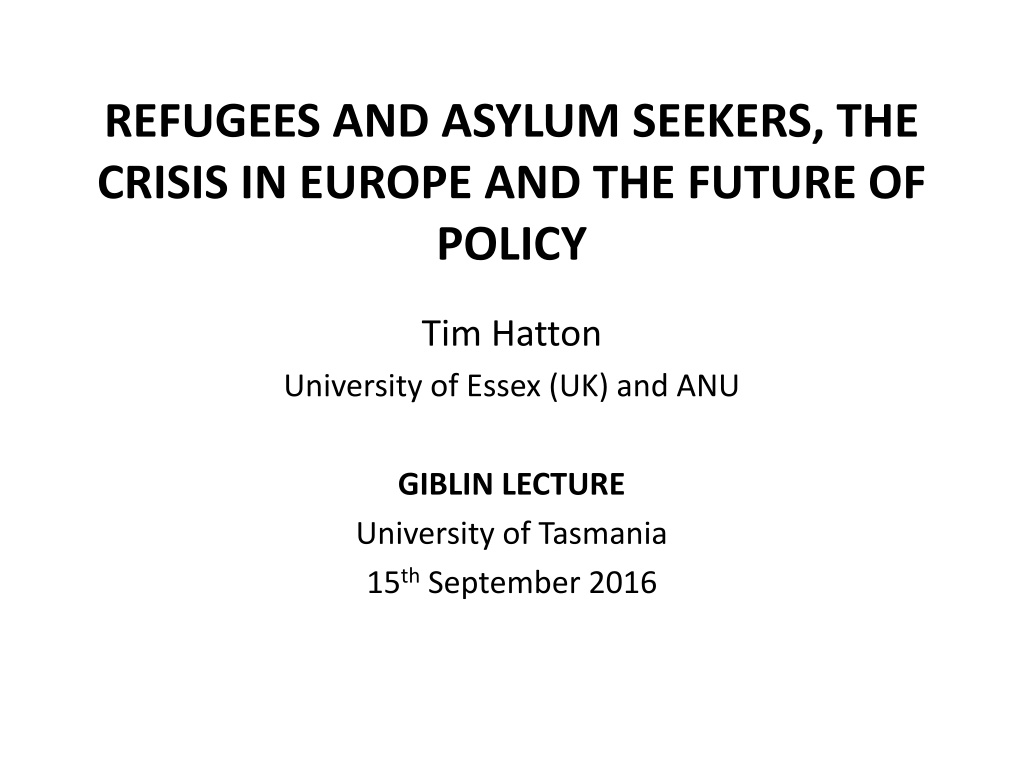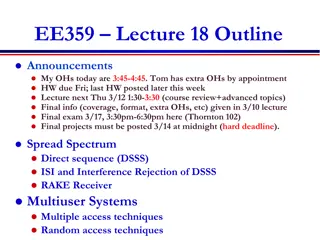
Challenges and Solutions in Europe's Asylum System
Explore the complexities of the recent migration crisis in Europe, focusing on asylum application determinants, public opinion, policy issues, and the need for a revamped resettlement program to aid those most in need.
Download Presentation

Please find below an Image/Link to download the presentation.
The content on the website is provided AS IS for your information and personal use only. It may not be sold, licensed, or shared on other websites without obtaining consent from the author. If you encounter any issues during the download, it is possible that the publisher has removed the file from their server.
You are allowed to download the files provided on this website for personal or commercial use, subject to the condition that they are used lawfully. All files are the property of their respective owners.
The content on the website is provided AS IS for your information and personal use only. It may not be sold, licensed, or shared on other websites without obtaining consent from the author.
E N D
Presentation Transcript
REFUGEES AND ASYLUM SEEKERS, THE CRISIS IN EUROPE AND THE FUTURE OF POLICY Tim Hatton University of Essex (UK) and ANU GIBLIN LECTURE University of Tasmania 15thSeptember 2016
Introduction The recent migration crisis In Europe has called into question the existing asylum system. Here I focus on: The determinants of asylum applications The public opinion and the political economy of asylum policy Three key issues: border control, resettlement and burden- sharing. I argue that the current system is inefficient and fails to help those most in need. It should be replaced by a substantial resettlement programme.
Refugees and Asylum Seekers 20 2000 Refugee stock (left scale) Asylum Applications (right scale) Applications to Europe (right scale) 18 1800 16 1600 Asylum Applications (thousands) Refugee Stock (millions) 14 1400 12 1200 10 1000 8 800 6 600 4 400 2 200 0 0 1982 1987 1992 1997 2002 2007 2012 Year
Asylum applications in 2011-15 per 1000 population 40 35 30 25 20 15 10 5 - Spain Malta Netherlands Hungary Portugal Greece Latvia Switzerland Finland Ireland Poland Norway Germany Italy Iceland Slovenia Sweden Denmark Cyprus France Luxembourg Bulgaria Romania Austria Czech Rep. Slovakia Belgium United Kingdom Estonia Lithuania
Recognition rates: 20 European countries 60 Convention recognition rate Total recognition rate 50 40 Percent 30 20 10 0 1982 1987 1992 1997 2002 2007 2012 Year
Determinants of Asylum Applications Applications to 19 countries (EU-14, Switzerland, Norway, US Canada, Australia) from 48 strife-prone origins, 1997-2014. Results from regressions with origin-destination dyad fixed effects: War, terror, human rights abuse. These are the most important, particularly the political terror scale and the F-H index of civil rights. Civil war not significant, until after 2011. Economic variables. Origin country GDP per capita is negatively related to applications. So economic imperatives matter: a ten percent increase in origin GDP per capita reduces applications by about five percent.
Effects of asylum policies Destination country conditions matter, particularly asylum policies. I use a 15-component policy index. Policies aimed at limiting access to the country s territory, (border controls, visa restrictions, carrier sanctions etc.) have strong deterrent effects. The process of determining refugee status (definition of a refugee, defining some claims as manifestly unfounded etc.) also have strong deterrent effects. Policies towards asylum seeker welfare (welfare benefits; dispersal, detention etc.) have no effect. It is the chance of gaining permanent settlement that drives asylum applications despite the hardships that this involves.
Predicted effects on asylum applications (percentage change in annual applications) 1997-2005 2005-2014 1997-2005 2005-2014 Australia -61.0 -6.8 Italy -31.3 25.5 Austria -46.6 0.0 Netherlands -52.8 -11.5 Belgium -17.5 -11.5 Norway -35.3 -21.7 Canada -19.2 -35.3 Poland -17.5 -6.8 Czech Rep. -6.8 0.0 Spain -33.9 -20.7 Denmark -42.8 0.0 Sweden 0.0 127.0 France -31.9 21.2 Switzerland -30.6 -40.7 Germany -9.6 3.1 UK -63.0 -22.4 Hungary 0.0 -11.5 USA -31.9 -25.0 Ireland -46.6 0.0 Total -32.1 4.6
Opinion in the European Social Survey In setting policy politicians must heed the opinions of the people that elect them. Here I look at 14 countries in the ESS in 2002 and 2014. These are the relevant questions: To what extent do you think [country] should allow people of a different race or ethnic group as most [country] people to come and live here? (many/some/a few/none). How about people from the poorer countries outside Europe? (many/some/a few/ none). Government should be generous judging applications for refugee status (strongly agree/agree/neither/disagree/ strongly disagree).
Public opinion on immigrants and refugees Immigration of different ethnic group Immigration from poor countries Be generous in judging refugee claims % few or none 2014 Change 50.3 41.1 37.1 73.2 25.7 38.7 53.1 38.8 50.1 32.4 23.5 42.7 7.6 35.8 39.3 % few or none 2014 Change 57.4 47.6 44.5 73.2 36.0 55.2 64.8 48.3 58.9 46.5 32.0 47.7 12.6 47.8 48.0 % disagree 2014 Change 37.9 44.4 34.9 45.2 34.8 29 21.8 17.5 20.7 46.2 18.3 8.6 9.8 24.1 28.1 Austria Belgium Switzerland Czech Rep. Germany Denmark Finland France Ireland Netherlands Norway Poland Sweden Slovenia Country average -16.3 -3.6 3.5 19.4 -18 -12.8 -9.6 -8.4 14.5 -9.6 -19.8 -1.5 -9.3 -8.3 3.9 13.9 23.4 -6.3 1.4 4.7 -2.9 22.5 2.6 -6.2 5.3 -2.8 4.3 4.0 -5.7 -15.1 -14.9 -17.3 -26 -21.3 -11.3 -1.2 -0.4 -28.7 -28 -4.5 -13.3 -25.4 -15.2 -8 -5.7
Changes in opinion 2002-2014 On average opinion has become more positive towards ethnic minority immigrants and more negative to immigration from poor countries. But it has become much more positive towards genuine refugees (by 15 percentage points). Correlation across 14 countries between change in anti- immigration opinion 2002 to 2014 and change in asylum applications per capita between 1997-2001 to 2009-2013. Asylum flow and opinion on different ethnic group : 0.37 Asylum flow and opinion on poor country immig : 0.48 Asylum flow and opinion on generous to refugees : -0.15
Preference versus salience Public opinion is not overwhelmingly negative, but there are two reasons why there is a shift against immigration. The first is that salience, as distinct from preference, has increased. Eurobarometer provides a measure of salience: What do you think are the two most important issues facing (our country) at the moment? (1 if immigration is mentioned). Salience has gone up steeply: the average for 21 European countries has increased from 6.9 percent in 2009 to 18.3. percent in 2015. Salience has the effect of magnifying preferences for or against immigration and so the debate becomes more polarised.
Illegal immigration The second reason is that the recent migration crisis has seen a steep rise in unauthorised border crossings. Frontex data shows that unauthorised entry increased from 95,000 in 2011 to 1.82 million in 2015. 3,700 drowned. Public opinion is massively opposed to illegal immigration. In the Transatlantic Trends survey (6 countries) 75 percent are worried about illegal immigration . This is more than double the level for legal immigration. In Eurobarometer (2015) 87 percent favour additional measures to fight illegal immigration.
Level of decision-making With declining trust in the EU one might have expected that public opinion would be increasingly against having immigration and asylum policies set at the EU level. The evidence from Eurobarometer for the EU-27 is that support for joint European immigration policy has been rising and is now as high as 70 percent on average. 68 percent wish to see additional measures to fight illegal immigration either at the EU-level or national and EU-level. This suggests that the EU has a greater mandate for setting and implementing immigration and asylum policies than is often supposed.
Summary so far Asylum applications have been rising, with increasing numbers taking risky passages via sea and land. Around half of asylum claims are rejected. The current system encourages mixed migration for access to an uncertain prospect of gaining recognition. Tougher asylum policies, especially those relating to access and processing, do reduce the number of applications. Public opinion in Europe is increasingly favourable to genuine refugees but is strongly against illegal immigration. There is surprisingly strong support for joint EU policy.
Border control Tougher border controls reduce asylum applications. The EU experience of 2013-15 illustrates the failure to implement controls on some routes (e.g. to Greece) rather than that border controls are inherently ineffective. The experience in the Western Mediterranean and in Australia suggests that it can have a big impact on maritime routes. But such policies have to be fairly draconian and are more easily achieved in cooperation with transit countries. The recent agreement between the EU and Turkey reduced unauthorised Aegean/Balkan crossings by 80 percent.
Resettlement Tougher border controls will filter out some genuine refugees so this needs to be complemented by a substantial resettlement programme. Poor countries of first asylum, host 86 percent of the world s refugees, many in desperate and protracted situations. About 80,000 are resettled each year but for 2016 the UNHCR identifies 1.15 million as genuine refugees in need of resettlement. Most go to US/Canada/Australia. 18 European countries participate but their total resettlement is 10,000. But in the short term it is hard to convince countries facing large numbers claims from spontaneous asylum applicants to embark on substantial resettlement.
Burden-sharing Hosting refugees satisfies humanitarian motives and can be interpreted as a public good. The benefit to individuals (and countries) is non-rival and non-excludable. But locally provided public goods will be under-provided. The social planner would set a higher number but there is an incentive to free ride. This is why it should be EU-led. The Common European Asylum System has focused on policy harmonisation, not on burden sharing. This has not helped to distribute asylum applications more evenly. To increase total resettlement capacity it is necessary to distribute refugees more evenly. This also implies tougher border controls to reduce spontaneous applications.
Lessons from Australia? Australia s migration crisis of 2012-13 soured public opinion and contributed to the downfall of the government. The Houston report (2012) recommended that irregular migrants should gain no advantage in obtaining status in Australia. But it also recommended that the numbers resettled should increase, doubling the humanitarian programme to 27,000. Operation Sovereign Borders has reduced the number of boat arrivals almost to zero. These tough measures have had the desired effect.
Lessons for Australia? The humanitarian programme is projected to increase from 13,750 to 18,500 by 2017-8. Perhaps it should be more than this. There are still 1,300 people in detention on Nauru and Manus Island, PNG. They face appalling conditions. My findings suggests that this has little deterrent effect. After the Pacific Solution of 2001/2, most of those in detention were gradually (and discreetly) released into Australia. It did not lead to a surge of boat arrivals. Time to do this again.
Conclusion The existing asylum system is inefficient and badly targeted. It fails to focus on those that most need our help. We, in the EU, could do better by: (a) tightening the borders, (b) resettling vastly more of those in the greatest need, and (c ) expanding resettlement capacity through burden-sharing. Any policy needs to be politically feasible, and these measures would work with the grain of public opinion, not against it. Otherwise we risk a massive backlash. It would be a constructive way of developing EU asylum policy in the longer term.







